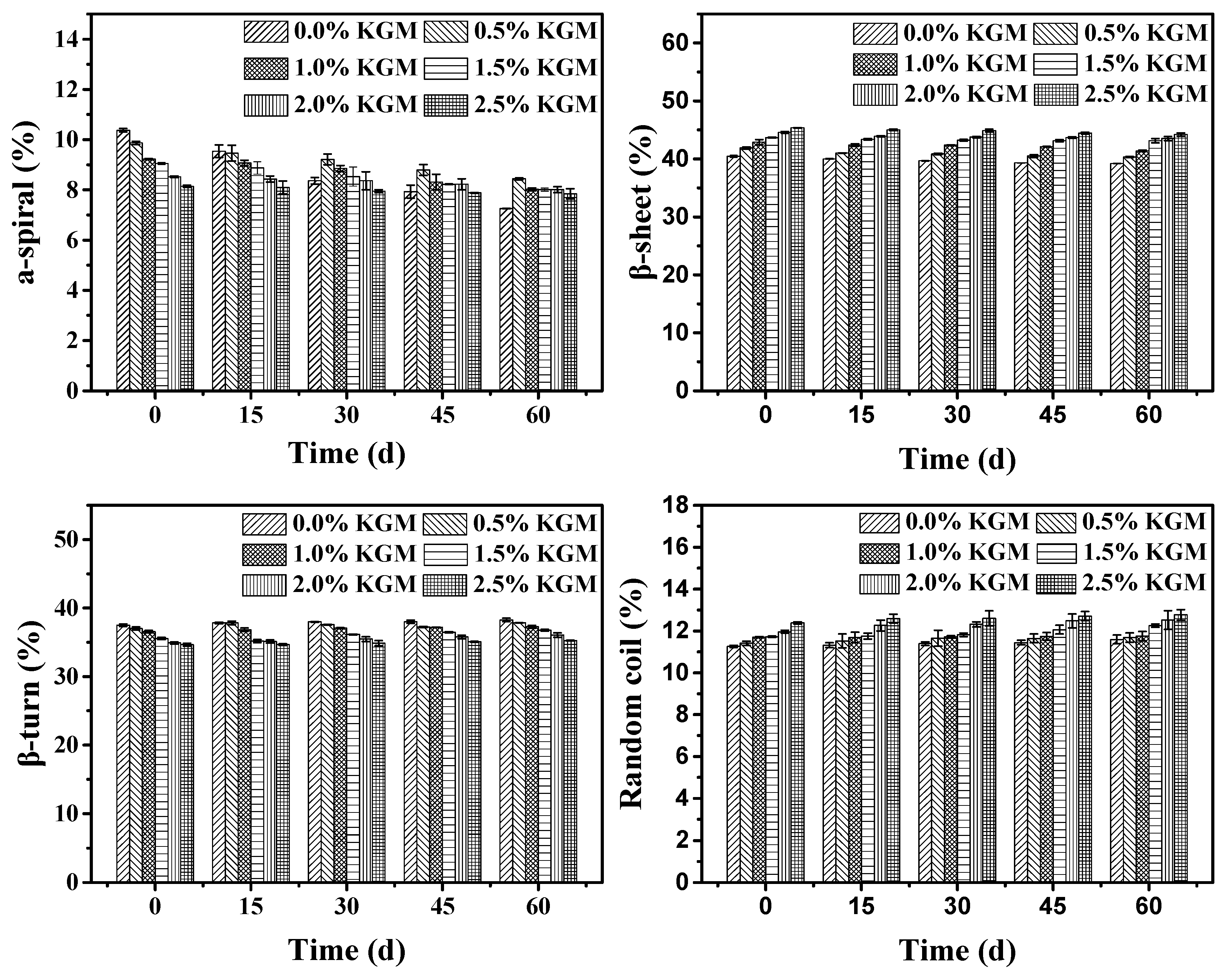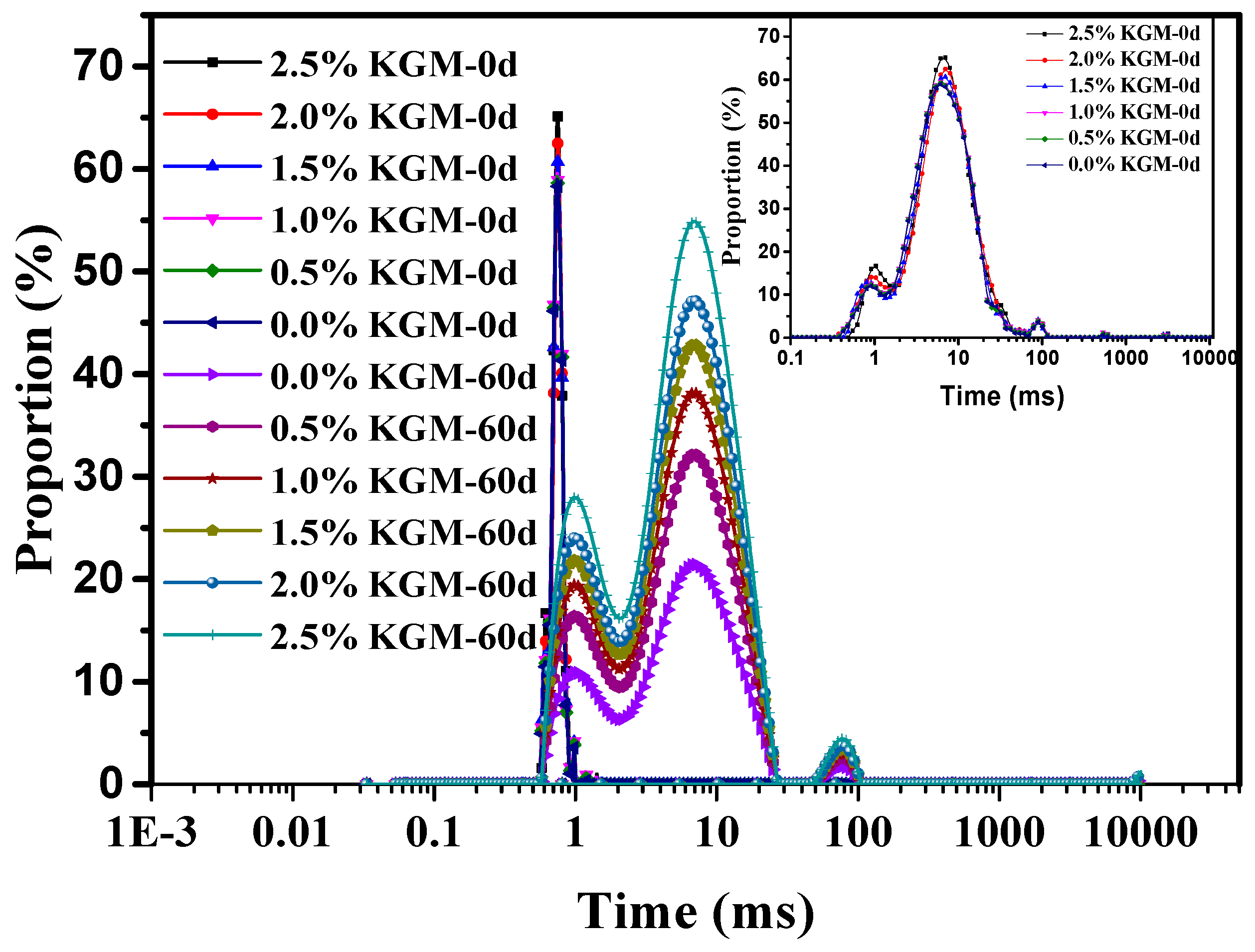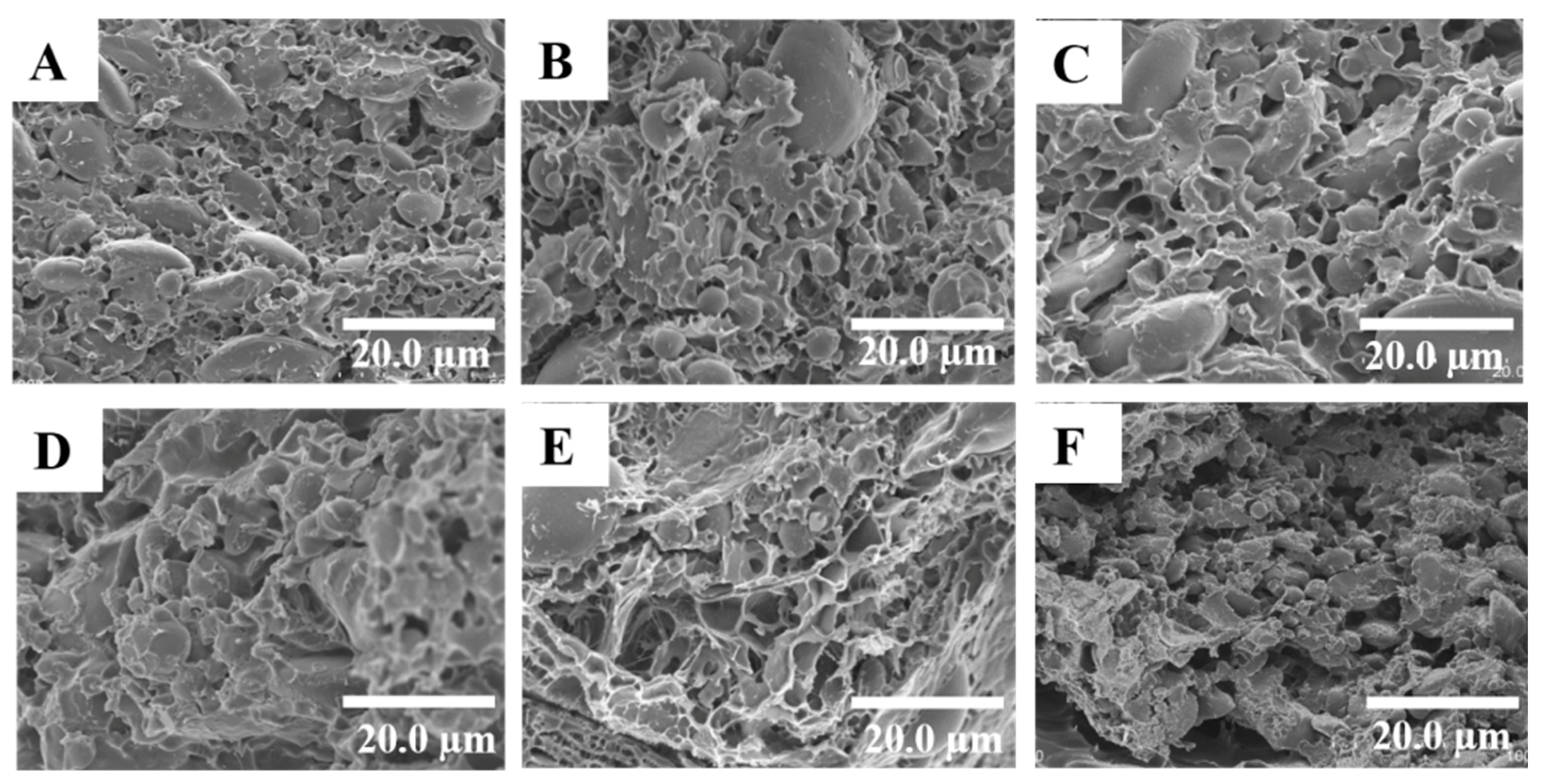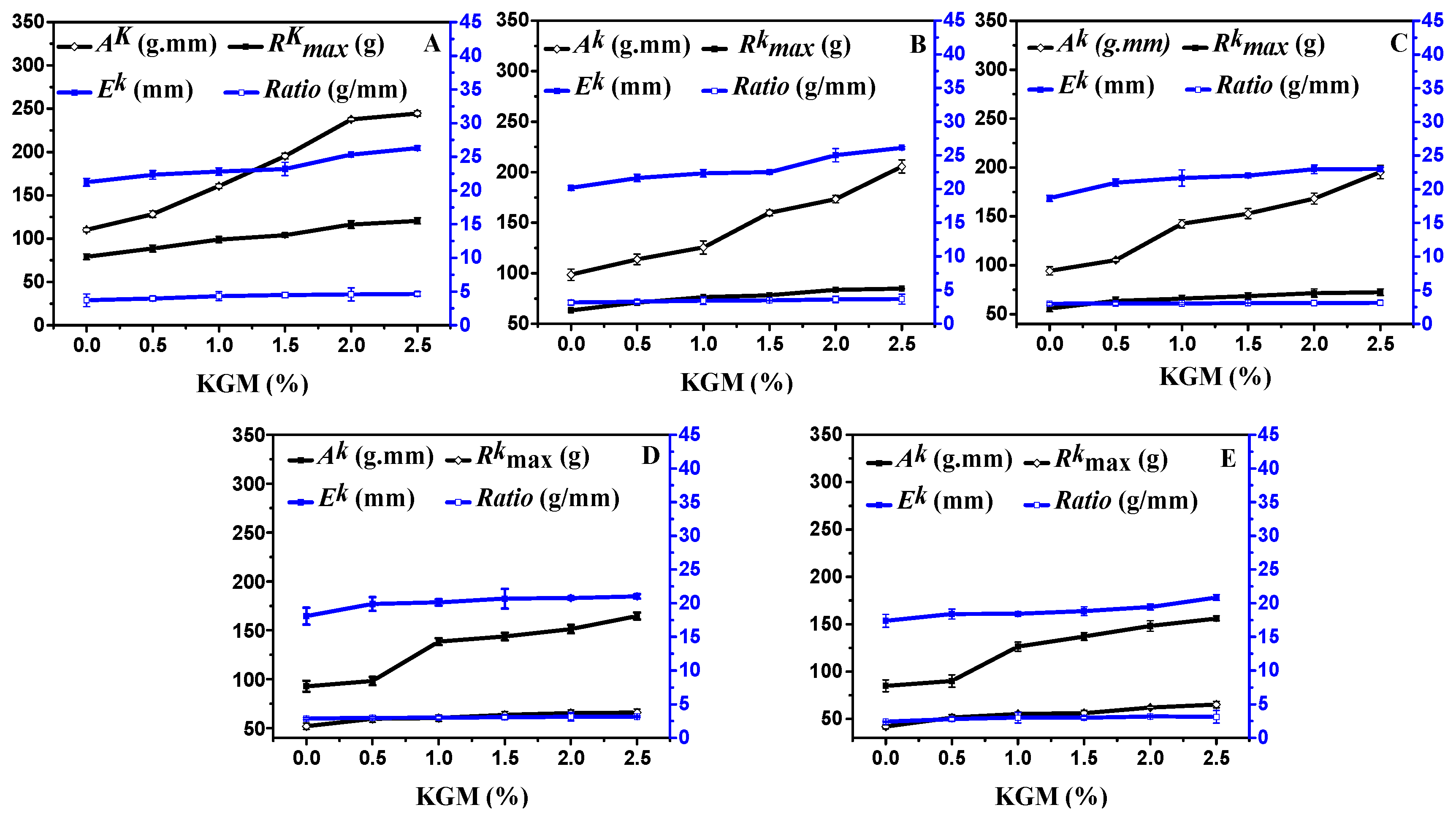Influence of Konjac Glucomannan and Frozen Storage on Rheological and Tensile Properties of Frozen Dough
Abstract
:1. Introduction
2. Materials and Methods
2.1. Materials
2.2. Dough Preparation
2.3. Molecular Weight (Mw) Analysis of Gluten Proteins
2.4. Free Sulfhydryl Content Analysis of Gluten Proteins
2.5. Secondary Structure Analysis of Gluten Proteins
2.6. Water Fluidity Analysis of Dough
2.7. Thermal Stability Analysis of Gluten Proteins
2.8. Microstructure of Dough
2.9. Rheological Properties of Dough
2.10. Tensile Tests of Dough
2.11. Statistical Analysis
3. Results and Discussion
3.1. Structural Properties of Gluten Proteins
3.1.1. Mw Analysis of Gluten Proteins
3.1.2. Secondary Structural Contents of Gluten Proteins
3.1.3. Free Sulfhydryl Content of Gluten Proteins
3.2. Interactions Between KGM and Gluten Proteins
3.2.1. T2 distributions of Frozen Dough
3.2.2. Thermal Stability of Frozen Dough
3.2.3. Microstructure of Frozen Dough
3.3. Rheological and Tensile Properties of Frozen Dough
3.3.1. Rheological Properties of Frozen Dough
3.3.2. Tensile Properties of Frozen Dough
3.4. Correlations Between Mechanical Characteristics and Structure Parameters
4. Conclusions
Supplementary Materials
Author Contributions
Funding
Conflicts of Interest
References
- Zhu, F. Influence of ingredients and chemical components on the quality of chinese steamed bread. Food Chem. 2014, 163, 154–162. [Google Scholar] [CrossRef]
- Kim, Y.S.; Huang, W.; Du, G.; Pan, Z.; Chung, O. Effects of trehalose, transglutaminase, and gum on rheological, fermentation, and baking properties of frozen dough. Food Res. Int. 2008, 41, 903–908. [Google Scholar] [CrossRef]
- Wang, P.; Zou, M.; Gu, Z.; Yang, R. Heat-induced polymerization behavior variation of frozen-stored gluten. Food Chem. 2018, 255, 242–251. [Google Scholar] [CrossRef] [PubMed]
- Selomulyo, V.O.; Zhou, W. Frozen bread dough: Effects of freezing storage and dough improvers. J. Cereal Sci. 2007, 45, 1–17. [Google Scholar] [CrossRef]
- Virginia, G.; Tzia, C. Frozen dough bread: Quality and textural behavior during prolonged storage-prediction of final product characteristics. J. Food Eng. 2007, 79, 929–934. [Google Scholar]
- Ronan, G.; Thomas, W.; Karen, H.; Francis, B. The effect of fluctuating vs. Constant frozen storage temperature regimes on some quality parameters of selected food products. LWT-Food Sci. Technol. 2002, 35, 190–200. [Google Scholar]
- Michał, H. Effects of trehalose and dough additives incorporating enzymes on physical characteristics and sensory properties of frozen savory Danish dough. LWT-Food Sci. Technol. 2017, 86, 603–610. [Google Scholar]
- Li, J.; Yadav, M.P.; Li, J. Effect of different hydrocolloids on gluten proteins, starch and dough microstructure. J. Cereal Sci. 2019, 87, 85–90. [Google Scholar] [CrossRef]
- Xuan, Y.F.; Zhang, Y.; Zhao, Y.Y.; Zheng, Z.; Jiang, S.T.; Zhong, X.Y. Effect of hydroxypropylmethylcellulose on transition of water status and physicochemical properties of wheat gluten upon frozen storage. Food Hydrocoll. 2017, 63, 35–42. [Google Scholar] [CrossRef]
- Zapata, F.; Zapata, E.; Rodríguez-Sandoval, E. Influence of guar gum on the baking quality of gluten-free cheese bread made using frozen and chilled dough. Int. J. Food Sci. Technol. 2019, 54, 313–324. [Google Scholar] [CrossRef]
- Zhang, C.; Chen, J.; Yang, F. Konjac glucomannan, a promising polysaccharide for OCDDS. Carbohydr. Polym. 2014, 104, 175–181. [Google Scholar] [CrossRef]
- Zhang, F.; Liu, M.; Mo, F.; Zhang, M.; Zheng, J. Effects of acid and salt solutions on the pasting, rheology and texture of lotus root starch–konjac glucomannan mixture. Polymers 2017, 9, 695. [Google Scholar] [CrossRef]
- Lucas, I.; Becker, T.; Jekle, M. Gluten polymer networks—A microstructural classification in complex systems. Polymers 2018, 10, 617. [Google Scholar] [CrossRef]
- França, C.; Nascimento, V.; Hernandez-Montelongo, J.; Machado, D.; Lancellotti, M.; Beppu, M. Synthesis and properties of silk fibroin/konjac glucomannan blend beads. Polymers 2018, 10, 923. [Google Scholar] [CrossRef]
- Internationa, A. Methods 44-15, 08-01, 46-11, 30-10 and 32-07 Approved Methods of the American Association of Cereal Chemists, 10th ed.; The americanassociation of Cereal Chemist, Inc.: St. Paul, MN, USA, 2000. [Google Scholar]
- Chaudhary, N.; Dangi, P.; Khatkar, B.S. Assessment of molecular weight distribution of wheat gluten proteins for chapatti quality. Food Chem. 2016, 199, 28–35. [Google Scholar] [CrossRef]
- Beveridge, T.; Toma, S.; Nakai, S. Determination of SH and SS groups in some food proteins using Ellman’s reagent. J. Cereal Sci. 1974, 39, 49–51. [Google Scholar] [CrossRef]
- Yang, N.; Ashton, J.; Kasapis, S. The influence of chitosan on the structural properties of whey protein and wheat starch composite systems. Food Chem. 2015, 179, 60–67. [Google Scholar] [CrossRef] [PubMed]
- Huang, L.; Zhang, X.; Zhang, H.; Wang, J. Interactions between dietary fiber and ferulic acid changed the aggregation of gluten in a whole wheat model system. LWT-Food Sci. Technol. 2018, 91, 55–62. [Google Scholar] [CrossRef]
- Wu, M.; Huang, X.; Gao, F.; Sun, Y.; Duan, H.; Li, D. Dynamic mechanical properties and fractal analysis of texturized soybean protein/wheat gluten composite produced by high moisture extrusion. Int. J. Food Sci. Technol. 2019, 54, 499–508. [Google Scholar] [CrossRef]
- Wang, P.; Chen, H.; Mohanad, B.; Xu, L.; Ning, Y.; Xu, J.; Wu, F.; Yang, N.; Jin, Z.; Xu, X. Effect of frozen storage on physico-chemistry of wheat gluten proteins: Studies on gluten-, glutenin- and gliadin-rich fractions. Food Hydrocoll. 2014, 39, 187–194. [Google Scholar] [CrossRef]
- Zhao, L.; Li, L.; Liu, G.; Chen, L.; Liu, X.; Zhu, J.; Li, B. Effect of freeze-thaw cycles on the molecular weight and size distribution of gluten. Food Res. Int. 2013, 53, 409–416. [Google Scholar] [CrossRef]
- Wang, P.; Lee, T.C.; Xu, X.; Jin, Z. The contribution of glutenin macropolymer depolymerization to the deterioration of frozen steamed bread dough quality. Food Chem. 2016, 211, 27–33. [Google Scholar] [CrossRef]
- Zhou, Y.; Cao, H.; Hou, M.; Nirasawa, S.; Tatsumi, E.; Foster, T.J.; Cheng, Y. Effect of konjac glucomannan on physical and sensory properties of noodles made from low-protein wheat flour. Food Res. Int. 2013, 51, 879–885. [Google Scholar] [CrossRef]
- Pelton, J.T.; McLean, L.R. Spectroscopic methods for analysis of protein secondary structure. Anal. Biochem. 2000, 277, 167–176. [Google Scholar] [CrossRef] [PubMed]
- Wieser, H. Chemistry of gluten proteins. Food. Microbiol. 2007, 24, 115–119. [Google Scholar] [CrossRef] [PubMed]
- Wang, P.; Yang, R.; Gu, Z.; Xu, X.; Jin, Z. Comparative study on the freeze stability of yeast and chemical leavened steamed bread dough. Food Chem. 2017, 221, 482–488. [Google Scholar] [CrossRef]
- Tao, H.; Zhang, B.; Wu, F.; Jin, Z.; Xu, X. Effect of multiple freezing/thawing-modified wheat starch on dough properties and bread quality using a reconstitution system. J. Cereal Sci. 2016, 69, 132–137. [Google Scholar] [CrossRef]
- Simmons, A.L.; Serventi, L.; Vodovotz, Y. Water dynamics in microwavable par-baked soy dough evaluated during frozen storage. Food Res. Int. 2012, 47, 58–63. [Google Scholar] [CrossRef]
- Ding, X.; Zhang, H.; Wang, L.; Qian, H.; Qi, X.; Xiao, J. Effect of barley antifreeze protein on thermal properties and water state of dough during freezing and freeze-thaw cycles. Food Hydrocoll. 2015, 47, 32–40. [Google Scholar] [CrossRef]
- Zhu, F. Modifications of konjac glucomannan for diverse applications. Food Chem. 2018, 256, 419–426. [Google Scholar] [CrossRef]
- Yan, H.; Cai, B.; Cheng, Y.; Guo, G.; Li, D.; Yao, X.; Ni, X.; Phillips, G.O.; Fang, Y.; Jiang, F. Mechanism of lowering water activity of konjac glucomannan and its derivatives. Food Hydrocoll. 2012, 26, 383–388. [Google Scholar] [CrossRef]
- Khatkar, B.S.; Barak, S.; Mudgil, D. Effects of gliadin addition on the rheological, microscopic and thermal characteristics of wheat gluten. Int. J. Biol. Macromol. 2013, 53, 38–41. [Google Scholar] [CrossRef]
- Wang, P.; Xu, L.; Nikoo, M.; Ocen, D.; Wu, F.; Yang, N.; Jin, Z.; Xu, X. Effect of frozen storage on the conformational, thermal and microscopic properties of gluten: Comparative studies on gluten-, glutenin- and gliadin-rich fractions. Food Hydrocoll. 2014, 35, 238–246. [Google Scholar] [CrossRef]
- Luo, W.H.; Sun, D.W.; Zhu, Z.W.; Wang, Q.J. Improving freeze tolerance of yeast and dough properties for enhancing frozen dough quality-a review of effective methods. Trends Food Sci. Technol. 2018, 72, 25–33. [Google Scholar] [CrossRef]
- Mariotti, M.; Alamprese, C. About the use of different sweeteners in baked goods. Influence on the mechanical and rheological properties of the doughs. LWT-Food Sci. Technol. 2012, 48, 9–15. [Google Scholar] [CrossRef]
- Angioloni, A.; Balestra, F.; Pinnavaia, G.G.; Rosa, M.D. Small and large deformation tests for the evaluation of frozen dough viscoelastic behaviour. J. Food Eng. 2008, 87, 527–531. [Google Scholar] [CrossRef]
- Ribotta, P.D.; Pérez, G.T.; León, A.E.; Añón, M.C. Effect of emulsifier and guar gum on micro structural, rheological and baking performance of frozen bread dough. Food Hydrocoll. 2004, 18, 305–313. [Google Scholar] [CrossRef]
- Behera, S.S.; Ray, R.C. Konjac glucomannan, a promising polysaccharide of Amorphophallus konjac K. Koch in health care. Int. J. Biol. Macromol. 2016, 92, 942–956. [Google Scholar] [CrossRef]
- Giannou, V.; Kessoglou, V.; Tzia, C. Quality and safety characteristics of bread made from frozen dough. Trends Food Sci. Technol. 2003, 14, 99–108. [Google Scholar] [CrossRef]
- Ban, C.; Yoon, S.; Han, J.; Kim, S.O.; Han, J.S.; Lim, S.; Choi, Y.J. Effects of freezing rate and terminal freezing temperature on frozen croissant dough quality. LWT-Food Sci. Technol. 2016, 73, 219–225. [Google Scholar] [CrossRef]
- Phimolsiripol, Y.; Siripatrawan, U.; Tulyathan, V.; Cleland, D.J. Effects of freezing and temperature fluctuations during frozen storage on frozen dough and bread quality. J. Food Eng. 2008, 84, 48–56. [Google Scholar] [CrossRef]
- Yi, J.; Kerr, W.L. Combined effects of freezing rate, storage temperature and time on bread dough and baking properties. LWT-Food Sci. Technol. 2009, 42, 1474–1483. [Google Scholar] [CrossRef]
- Xin, C.; Nie, L.; Chen, H.; Li, J.; Li, B. Effect of degree of substitution of carboxymethyl cellulose sodium on the state of water, rheological and baking performance of frozen bread dough. Food Hydrocoll. 2018, 80, 8–14. [Google Scholar] [CrossRef]







| Storage Time (d) | KGM (%) | Protein Molecular Weight | ||||
|---|---|---|---|---|---|---|
| Mw (Da) | Peak 1 Area (%) | Peak 2 Area (%) | Peak 3 Area (%) | Peak 4 Area (%) | ||
| 0 | 0 | 1.98 × 105 | 23.35 ± 0.27 f | 48.59 ± 0.37 f | 18.52 ± 0.11 a | 9.54 ± 0.03 a |
| 0.5 | 2.10 × 105 | 25.23 ± 0.09 e | 49.56 ± 0.11 e | 18.12 ± 0.13 b | 7.09 ± 0.04 b | |
| 1.0 | 2.16 × 105 | 26.13 ± 0.11 d | 50.73 ± 0.12 cd | 17.62 ± 0.31 c | 5.52 ± 0.04 c | |
| 1.5 | 2.18 × 105 | 27.62 ± 0.08 c | 51.08 ± 0.45 bc | 17.22 ± 0.04 d | 4.08 ± 0.04 d | |
| 2.0 | 2.20 × 105 | 29.13 ± 0.16 ab | 51.20 ± 0.22 b | 17.03 ± 0.16 de | 2.64 ± 0.03 e | |
| 2.5 | 2.25 × 105 | 29.24 ± 0.14 a | 51.83 ± 0.31 a | 16.63 ± 0.03 f | 2.30 ± 0.06 f | |
| 15 | 0 | 1.87 × 105 | 22.12 ± 0.11 e | 45.36 ± 0.06 d | 18.94 ± 0.10 d | 13.58 ± 0.03 c |
| 0.5 | 2.05 × 105 | 22.61 ± 0.17 d | 45.61 ± 0.09 c | 18.66 ± 0.10 a | 12.84 ± 0.15 a | |
| 1.0 | 2.10 × 105 | 23.17 ± 0.09 d | 46.57 ± 0.15 c | 18.47 ± 0.06 b | 11.79 ± 0.10 b | |
| 1.5 | 2.13 × 105 | 23.52 ± 0.06 c | 47.69 ± 0.13 c | 18.36 ± 0.15 b | 10.43 ± 0.04 d | |
| 2.0 | 2.16 × 105 | 24.63 ± 0.03 b | 48.70 ± 0.10 b | 17.95 ± 0.02 c | 8.72 ± 0.06 e | |
| 2.5 | 2.22 × 105 | 25.39 ± 0.01 a | 49.26 ± 0.16 a | 17.75 ± 0.06 c | 7.60 ± 0.07 f | |
| 30 | 0 | 1.65 × 105 | 21.14 ± 0.10 e | 44.71 ± 0.13 d | 19.29 ± 0.08 e | 14.86 ± 0.07 a |
| 0.5 | 2.00 × 105 | 21.53 ± 0.04 d | 45.07 ± 0.10 a | 19.16 ± 0.10 d | 14.24 ± 0.04 b | |
| 1.0 | 2.06 × 105 | 21.83 ± 0.13 c | 45.20 ± 0.12 b | 18.89 ± 0.17 c | 14.08 ± 0.05 c | |
| 1.5 | 2.10 × 105 | 22.17 ± 0.08 c | 45.98 ± 0.09 b | 18.89 ± 0.14 b | 12.96 ± 0.06 d | |
| 2.0 | 2.11 × 105 | 23.40 ± 0.07 b | 46.74 ± 0.17 c | 18.62 ± 0.08 b | 11.78 ± 0.09 e | |
| 2.5 | 2.14 × 105 | 24.94 ± 0.14 a | 47.46 ± 0.17 c | 18.35 ± 0.05 a | 9.26 ± 0.02 f | |
| 45 | 0 | 1.51 × 105 | 21.09 ± 0.08 d | 41.14 ± 0.01 e | 19.93 ± 0.12 f | 17.84 ± 0.17 a |
| 0.5 | 1.84 × 105 | 21.46 ± 0.04 d | 41.36 ± 0.06 d | 19.63 ± 0.10 e | 16.95 ± 0.01 b | |
| 1.0 | 2.01 × 105 | 21.17 ± 0.12 c | 43.62 ± 0.11 c | 19.01 ± 0.04 d | 16.22 ± 0.13 c | |
| 1.5 | 2.07 × 105 | 22.76 ± 0.09 b | 44.60 ± 0.16 c | 18.99 ± 0.06 c | 13.65 ± 0.10 d | |
| 2.0 | 2.08 × 105 | 22.93 ± 0.05 b | 46.56 ± 0.01 b | 18.65 ± 0.10 b | 11.86 ± 0.01 e | |
| 2.5 | 2.11 × 105 | 24.58 ± 0.12 a | 46.75 ± 0.15 a | 18.33 ± 0.12 a | 11.34 ± 0.05 f | |
| 60 | 0 | 1.39 × 105 | 20.54 ± 0.11 e | 41.05 ± 0.10 f | 20.06 ± 0.10 f | 18.35 ± 0.16 a |
| 0.5 | 1.75 × 105 | 20.83 ± 0.05 d | 41.80 ± 0.14 e | 19.78 ± 0.15 e | 17.59 ± 0.10 b | |
| 1.0 | 2.00 × 105 | 21.46 ± 0.12 c | 42.36 ± 0.14 d | 19.37 ± 0.19 d | 16.81 ± 0.12 c | |
| 1.5 | 2.06 × 105 | 21.62 ± 0.05 c | 42.97 ± 0.19 c | 19.03 ± 0.12 c | 16.38 ± 0.04 d | |
| 2.0 | 2.06 × 105 | 22.15 ± 0.42 b | 43.50 ± 0.15 b | 18.98 ± 0.14 b | 15.37 ± 0.10 e | |
| 2.5 | 2.08 × 105 | 23.24 ± 0.11 a | 44.39 ± 0.25 a | 18.29 ± 0.18 a | 14.08 ± 0.09 f | |
| Storage Time (d) | KGM (%) | T2 Distribution Area (%) | Thermal Parameter | |||
|---|---|---|---|---|---|---|
| T21 | T22 | T23 | Tp (°C) | ∆H/(J/g) | ||
| 0 | 0 | 10.76 ± 0.12 d | 80.05 ± 0.56 c | 9.19 ± 0.12 a | 54.74 ± 2.35 d | 114.45 ± 6.54 f |
| 0.5 | 11.04 ± 0.16 c | 81.89 ± 0.35 b | 6.47 ± 0.16 b | 62.70 ± 1.56 c | 123.49 ± 3.31 e | |
| 1.0 | 11.18 ± 0.43 c | 81.99 ± 0.45 b | 5.83 ± 0.09 c | 67.30 ± 1.30 b | 129.07 ± 1.33 d | |
| 1.5 | 11.29 ± 0.48 bc | 82.80 ± 0.79 b | 4.91 ± 0.18 d | 67.43 ± 2.13 bc | 153.92 ± 4.21 bc | |
| 2.0 | 11.74 ± 0.08 b | 84.61 ± 0.35 a | 3.65 ± 0.23 e | 69.54 ± 1.16 b | 156.22 ± 1.64 b | |
| 2.5 | 12.05 ± 0.14 a | 85.55 ± 1.79 a | 2.40 ± 0.44 f | 72.75 ± 1.25 a | 160.32 ± 2.35 a | |
| 15 | 0 | 10.17 ± 0.02 a | 78.32 ± 0.06 a | 11.51 ± 0.03 a | 56.65 ± 1.25 f | 112.10 ± 3.56 f |
| 0.5 | 10.23 ± 0.03 b | 81.03 ± 0.43 b | 8.74 ± 0.01 b | 63.58 ± 2.21 de | 119.04 ± 2.54 de | |
| 1.0 | 10.50 ± 0.08 c | 81.24 ± 0.03 b | 8.26 ± 0.03 c | 67.94 ± 2.58 cd | 120.47 ± 1.58 cd | |
| 1.5 | 10.68 ± 0.12 cd | 81.84 ± 0.06 c | 7.48 ± 0.21 d | 68.16 ± 2.34 bc | 125.93 ± 4.23 bc | |
| 2.0 | 10.73 ± 0.21 cd | 82.22 ± 0.43 cd | 7.05 ± 0.37 e | 69.98 ± 1.24 b | 128.70 ± 2.58 ab | |
| 2.5 | 10.91 ± 0.10 cd | 82.37 ± 0.21 de | 6.72 ± 0.09 f | 73.53 ± 1.99 a | 130.86 ± 4.54 a | |
| 30 | 0 | 9.62 ± 0.32 a | 78.13 ± 0.21 a | 12.25 ± 0.25 a | 58.42 ± 2.34 e | 106.64 ± 3.45 e |
| 0.5 | 9.82 ± 0.05 b | 80.98 ± 0.21 b | 9.20 ± 0.41 b | 65.72 ± 2.58 cd | 110.24 ± 4.12 cd | |
| 1.0 | 10.36 ± 0.11 c | 81.01 ± 0.31 bc | 8.63 ± 0.65 cd | 70.80 ± 3.16 bc | 111.85 ± 3.87 cd | |
| 1.5 | 10.42 ± 0.21 cd | 81.54 ± 0.33 bc | 8.04 ± 0.22 cd | 71.05 ± 2.87 ab | 116.41 ± 2.56 c | |
| 2.0 | 10.53 ± 0.11 cd | 81.77 ± 0.12 cd | 7.70 ± 0.10 e | 74.23 ± 3.01 ab | 122.04 ± 2.88 ab | |
| 2.5 | 10.83 ± 0.21 cd | 81.78 ± 0.44 cde | 7.39 ± 0.43 f | 76.77 ± 1.58 a | 125.93 ± 3.66 a | |
| 45 | 0 | 9.43 ± 0.28 a | 77.96 ± 0.31 a | 12.61 ± 0.36 a | 59.66 ± 1.05 e | 91.40 ± 3.54 ef |
| 0.5 | 9.63 ± 0.13 b | 80.41 ± 0.06 b | 9.96 ± 0.22 b | 67.38 ± 2.71 cd | 94.56 ± 3.68 e | |
| 1.0 | 9.88 ± 0.25 bc | 80.96 ± 0.45 c | 9.16 ± 0.37 cd | 71.21 ± 2.11 cd | 104.91 ± 3.44 d | |
| 1.5 | 10.06 ± 0.38 bc | 81.12 ± 0.43 d | 8.82 ± 0.06 cd | 73.48 ± 3.25 bc | 110.36 ± 3.25 c | |
| 2.0 | 10.14 ± 0.09 bc | 81.32 ± 0.22 de | 8.54 ± 0.23 ef | 76.02 ± 3.66 ab | 116.78 ± 2.58 ab | |
| 2.5 | 10.60 ± 0.23 bcd | 81.54 ± 0.56 ef | 7.86 ± 0.41 e | 79.43 ± 3.54 a | 117.23 ± 3.42 a | |
| 60 | 0 | 9.20 ± 0.01 a | 77.65 ± 0.41 a | 13.15 ± 0.24 a | 62.62 ± 1.22 f | 82.78 ± 2.53 ef |
| 0.5 | 9.46 ± 0.26 b | 79.20 ± 0.26 b | 11.34 ± 0.21 b | 69.02 ± 3.47 de | 85.14 ± 2.68 de | |
| 1.0 | 9.50 ± 0.33 bc | 80.42 ± 0.22 bc | 10.08 ± 0.44 c | 73.99 ± 2.55 cd | 87.10 ± 2.54 d | |
| 1.5 | 9.91 ± 0.02 bc | 80.54 ± 0.11 bc | 9.55 ± 0.09 d | 75.43 ± 3.68 bc | 93.96 ± 3.65 bc | |
| 2.0 | 9.94 ± 0.12 bc | 80.88 ± 0.03 d | 9.18 ± 0.15 ef | 76.28 ± 3.87 ab | 98.75 ± 3.87 ab | |
| 2.5 | 10.09 ± 0.26 bc | 80.96 ± 0.09 d | 8.95 ± 0.22 ef | 80.23 ± 2.44 a | 104.91 ± 4.57 a | |
| Mw | SHF | SS | β-Sheet | T22 | T23 | △H | Tp | |
|---|---|---|---|---|---|---|---|---|
| Rkmax (g) | 0.899 ** | −0.986 ** | 0.996 ** | 0.990 ** | 0.925 ** | −0.951 ** | 0.960 ** | 0.962 ** |
| Ek (mm) | 0.785 ** | −0.913 ** | 0.970 ** | 0.951 ** | 0.825 ** | −0.862 ** | 0.895 ** | 0.973 ** |
| Ak (g.mm) | 0.855 ** | −0.966 ** | 0.990 ** | 0.980 ** | 0.883 ** | −0.919 ** | 0.923 ** | 0.923 ** |
| Stretch ratio | 0.659 ** | −0.914 ** | 0.947 ** | 0.917 * | 0.784 ** | −0.812 ** | 0.811 ** | 0.854 ** |
© 2019 by the authors. Licensee MDPI, Basel, Switzerland. This article is an open access article distributed under the terms and conditions of the Creative Commons Attribution (CC BY) license (http://creativecommons.org/licenses/by/4.0/).
Share and Cite
Cui, T.; Liu, R.; Wu, T.; Sui, W.; Zhang, M. Influence of Konjac Glucomannan and Frozen Storage on Rheological and Tensile Properties of Frozen Dough. Polymers 2019, 11, 794. https://doi.org/10.3390/polym11050794
Cui T, Liu R, Wu T, Sui W, Zhang M. Influence of Konjac Glucomannan and Frozen Storage on Rheological and Tensile Properties of Frozen Dough. Polymers. 2019; 11(5):794. https://doi.org/10.3390/polym11050794
Chicago/Turabian StyleCui, Tingting, Rui Liu, Tao Wu, Wenjie Sui, and Min Zhang. 2019. "Influence of Konjac Glucomannan and Frozen Storage on Rheological and Tensile Properties of Frozen Dough" Polymers 11, no. 5: 794. https://doi.org/10.3390/polym11050794







